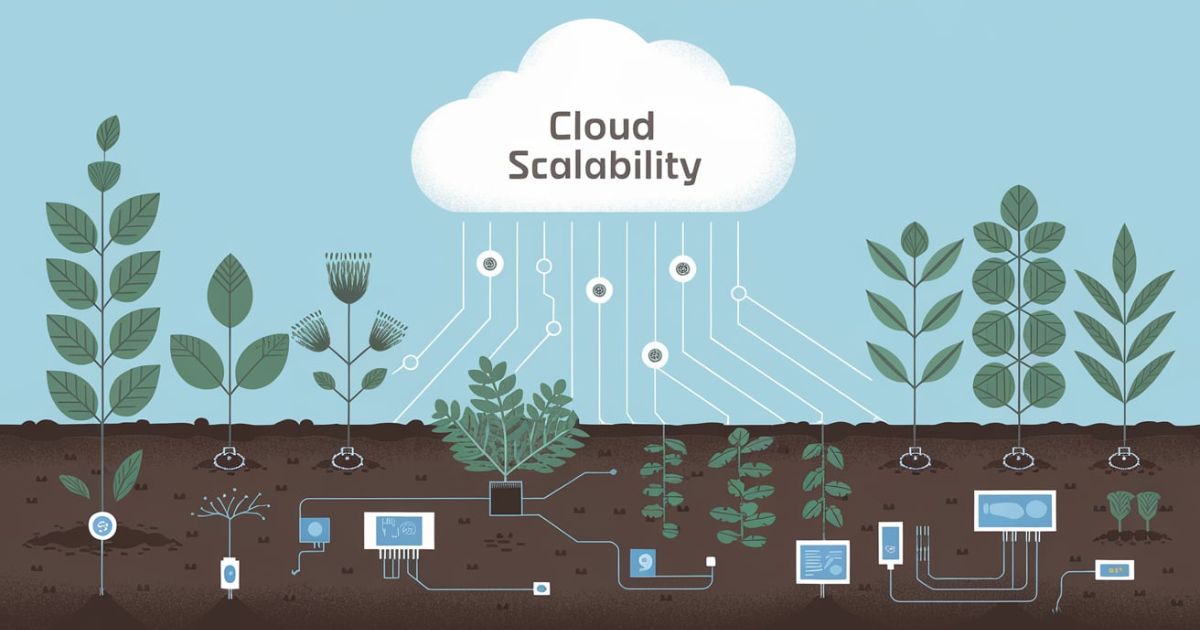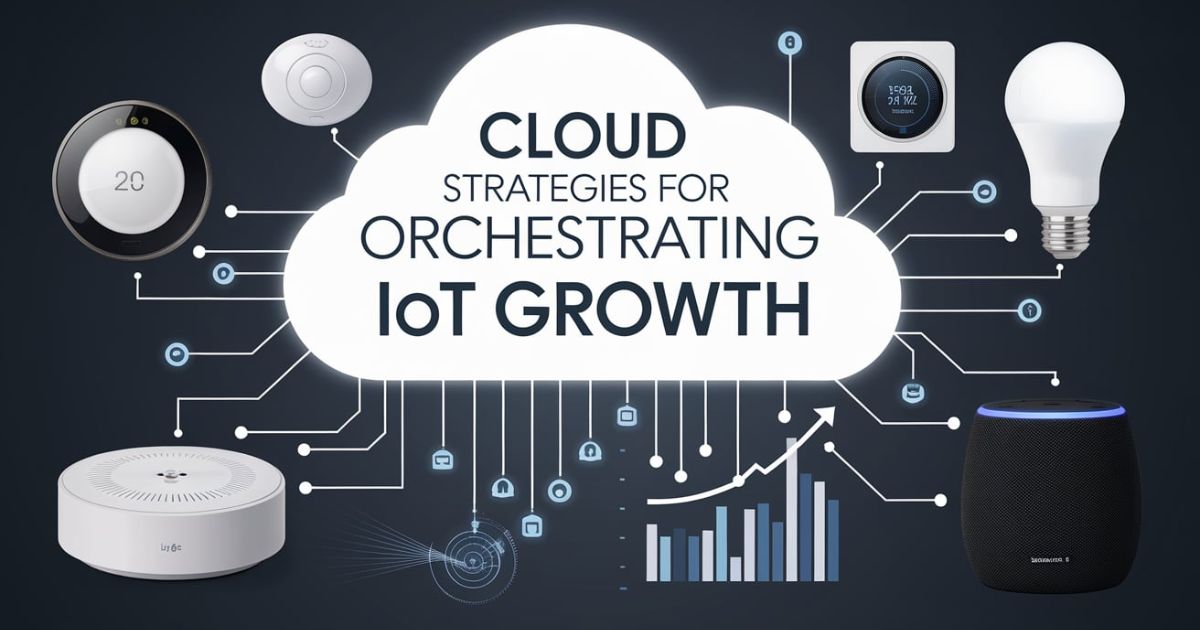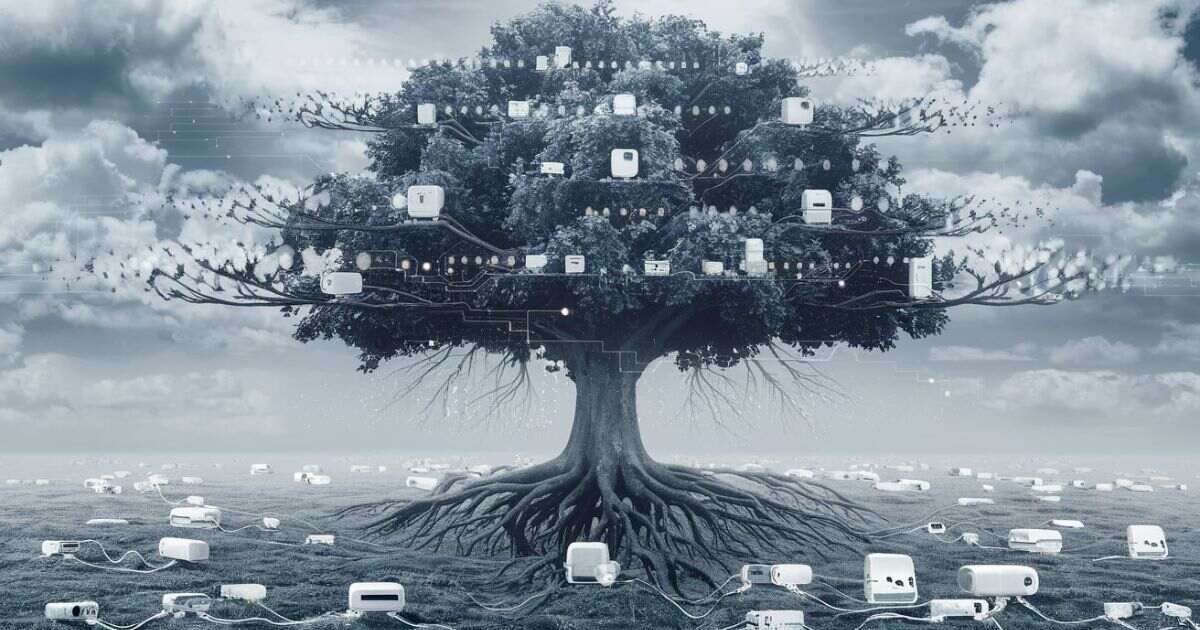In the ever-evolving landscape of digital transformation, businesses are increasingly turning to the powerful combination of the Internet of Things (IoT) and cloud computing to drive innovation, efficiency, and growth.
This symbiotic relationship between IoT and cloud scalability is revolutionizing industries across the board, enabling companies to expand their digital footprint from modest beginnings to towering heights of technological sophistication.
In this comprehensive guide, we’ll explore how to orchestrate the symphony of IoT growth and cloud scalability, taking your business from a digital sprout to a mighty sequoia in the forest of connected technologies.
The Digital Forest: An Introduction
Imagine a vast digital ecosystem where every device, sensor, and machine is interconnected, sharing data and insights in real-time.
This is the world of IoT, a rapidly expanding network that’s transforming how we live and work.
But for this network to thrive and grow, it needs a robust, flexible infrastructure – and that’s where cloud scalability comes into play.
From Sprout to Sequoia: Orchestrating the Symphony of IoT Growth and Cloud Scalability isn’t just a catchy phrase; it’s a roadmap for businesses looking to harness the full potential of these technologies.
By carefully orchestrating the interplay between IoT growth and cloud scalability, companies can:
- Rapidly deploy and scale new solutions
- Gain real-time insights from vast amounts of data
- Optimize operations for unprecedented efficiency
- Create new revenue streams through data-driven business models
- Stay agile in the face of changing market demands
For US businesses, mastering this orchestration is no longer a luxury – it’s a necessity for staying competitive in a global marketplace.
Let’s dive deeper into how you can nurture your IoT ecosystem from a tiny sprout to a towering sequoia.
Planting the Seeds: IoT Fundamentals
Before we can orchestrate the symphony of IoT growth and cloud scalability, we need to understand the basic components of our digital orchestra.
At its core, IoT refers to the network of physical objects embedded with sensors, software, and other technologies that enable them to collect and exchange data.
The IoT ecosystem encompasses a wide range of devices and applications:
- Consumer IoT: Smart home devices, wearables, connected cars
- Industrial IoT (IIoT): Manufacturing equipment, supply chain sensors, smart agriculture systems
- Smart City Infrastructure: Traffic management, waste management, environmental monitoring
- Healthcare IoT: Remote patient monitoring, smart medical devices, telemedicine platforms
- Energy and Utilities: Smart grids, oil and gas monitoring, renewable energy management
At the heart of this ecosystem is data – the lifeblood that flows through the veins of our digital forest. Every connected device generates a stream of information, from simple status updates to complex sensor readings.
This data, when properly collected, analyzed, and acted upon, can provide unprecedented insights and drive intelligent decision-making.
“The Internet of Things has the potential to change the world, just as the Internet did. Maybe even more so.” – Kevin Ashton, technology pioneer who coined the term “Internet of Things”
Cloud Scalability: Fertile Soil for Your IoT Garden

Now that we’ve planted our IoT seeds, let’s explore the fertile soil that allows them to grow: cloud scalability.
Cloud computing provides the essential infrastructure for IoT orchestration, offering a range of benefits that make it the ideal platform for nurturing your digital ecosystem:
- Elastic Resources: The ability to scale computing power and storage up or down based on demand
- Global Reach: Distributed data centers that enable low-latency access from anywhere in the world
- Advanced Analytics: Powerful tools for processing and deriving insights from vast amounts of IoT data
- Pay-as-you-go Pricing: Cost models that align with the growth of your IoT deployment
- Managed Services: Reduces the burden on in-house IT teams, allowing them to focus on innovation
The elasticity of cloud resources is particularly crucial for orchestrating IoT growth. As your network of devices expands, your cloud infrastructure can stretch to accommodate the increased data flow and processing needs.
This eliminates the need for massive upfront investments in hardware and allows for organic, sustainable growth.
Let’s compare traditional on-premises infrastructure with cloud scalability for IoT:
| Aspect | On-Premises Infrastructure | Cloud Scalability |
| Initial Cost | High (hardware, software, setup) | Low (pay-as-you-go) |
| Scalability | Limited by physical hardware | Nearly unlimited |
| Time to Scale | Weeks to months | Minutes to hours |
| Global Reach | Difficult and expensive | Built-in |
| Maintenance | In-house IT team required | Managed by cloud provider |
| Innovation Speed | Slow (hardware-dependent) | Rapid (software-defined) |
| Data Analysis | Limited by on-site resources | Access to advanced AI/ML tools |
As we can see, cloud scalability provides the ideal environment for orchestrating the symphony of IoT growth, allowing businesses to start small and scale rapidly as their needs evolve.
Sprouting Success: Early Stages of IoT Implementation
With our understanding of IoT fundamentals and cloud scalability in place, let’s look at how businesses can start their journey from sprout to sequoia.
The key to successful IoT orchestration is to start small with pilot projects that prove the technology’s worth while laying the groundwork for future expansion.
Here’s a step-by-step guide to get your IoT implementation off the ground:
- Identify a Specific Business Problem: Look for areas where real-time data could make a significant impact on efficiency, customer experience, or revenue.
- Choose Your Devices: Select sensors or smart devices that can provide the necessary data to address your identified problem.
- Set Up Your Cloud Environment: Decide between public, private, or hybrid cloud based on your security needs, data volumes, and regulatory requirements.
- Implement Data Collection and Analysis: Start gathering and processing data to derive actionable insights.
- Act on Insights: Use the information to make data-driven decisions and improvements in your operations.
- Evaluate and Iterate: Assess the impact of your IoT implementation and refine your approach based on real-world results.
Case Study: SmartFarm Solutions
Let’s look at how a US-based agricultural technology company, SmartFarm Solutions, orchestrated its IoT growth and cloud scalability:
- Year 1: Started with 500 soil moisture sensors across 10 farms, using a public cloud for data storage and basic analytics.
- Year 2: Expanded to 5,000 sensors, added weather stations, and implemented edge computing for real-time irrigation decisions.
- Year 3: Reached 50,000 sensors across multiple states, integrated drone imagery analysis, and moved to a hybrid cloud for enhanced data security and compliance.
- Year 5: Now managing over 500,000 sensors nationwide, using AI for predictive crop management, and offering a SaaS platform for other agribusinesses.
Key to SmartFarm’s success was its strategic approach to orchestrating IoT growth and cloud scalability.
By starting small and leveraging cloud resources, they were able to prove the value of their solution and scale rapidly without massive upfront investments.
Growing Pains: Scaling Challenges in the IoT Symphony
As your IoT ecosystem expands from a sprout to a sapling, you’ll inevitably face some growing pains. Successfully orchestrating the symphony of IoT growth and cloud scalability requires addressing these challenges head-on:
- Data Deluge: The sheer volume of data generated by IoT devices can overwhelm traditional data management systems.
- Security Concerns: Each new device added to your network is a potential entry point for cyber attacks.
- Integration Hurdles: Legacy systems may struggle to communicate with new IoT devices and cloud platforms.
- Bandwidth Limitations: As data volume grows, network capacity can become a bottleneck.
- Device Management: Keeping track of and maintaining thousands or millions of devices is a complex task.
To overcome these challenges and continue orchestrating your IoT growth, consider implementing the following strategies:
- Data Governance: Establish clear policies for data collection, storage, and usage to manage the data deluge effectively.
- Security by Design: Implement robust security measures at every level of your IoT ecosystem, from device firmware to cloud storage.
- API-First Approach: Use well-defined APIs to facilitate integration between different systems and devices.
- Edge Computing: Process data closer to the source to reduce bandwidth requirements and improve response times.
- Centralized Device Management: Implement a robust IoT device management platform that can handle provisioning, updates, and monitoring at scale.
By addressing these challenges proactively, you can ensure that your IoT symphony continues to grow harmoniously, even as it increases in complexity and scale.
Read This Post: Art:zoyzc-jsfky= People: Envisioning Humanity Through Technology
Cloud Strategies for Orchestrating IoT Growth

As your IoT implementation grows from a sapling to a mature tree, you’ll need to leverage advanced cloud strategies to maintain scalability and performance. Here are some key approaches to consider:
Microservices Architecture
Microservices break down your application into smaller, independent services that can be developed, deployed, and scaled individually. This approach offers several benefits for orchestrating IoT growth:
- Flexibility: Easy to update or replace individual components without affecting the entire system.
- Scalability: Can scale specific services based on demand, optimizing resource usage.
- Resilience: Failure in one service doesn’t bring down the entire application.
Edge Computing
Edge computing brings processing power closer to the source of data generation, reducing latency and bandwidth usage. For IoT orchestration, this means:
- Faster Response Times: Critical for applications like autonomous vehicles or industrial safety systems.
- Reduced Cloud Costs: By processing data locally, you send less information to the cloud.
- Enhanced Privacy: Sensitive data can be processed locally, never leaving the edge device.
Containerization and Kubernetes
Containers package applications with their dependencies, ensuring consistency across different environments.
Kubernetes, an open-source container orchestration platform, helps manage these containers at scale. Together, they provide:
- Portability: Easy to move applications between different cloud environments.
- Efficient Resource Utilization: Kubernetes can automatically scale containers based on demand.
- Simplified Management: Automates many aspects of deployment, scaling, and operations.
By implementing these strategies, businesses can create a flexible, scalable foundation for their growing IoT ecosystem.
This foundation allows for seamless expansion from a few hundred devices to millions, all while maintaining performance and reliability – essential for orchestrating the symphony of IoT growth and cloud scalability.
The Sequoia Stage: Large-Scale IoT Deployment
As your IoT implementation reaches the sequoia stage, you’ll need to manage an ever-growing forest of connected devices. Here are some strategies for large-scale IoT deployment:
- Centralized Device Management: Implement a robust IoT device management platform that can handle:
- Over-the-air updates
- Remote diagnostics
- Security patch deployment
- Device provisioning and decommissioning
- AI and Machine Learning Integration: Leverage advanced analytics to:
- Predict device failures before they occur
- Optimize resource allocation
- Identify patterns and insights in vast amounts of IoT data
- Digital Twins: Create virtual replicas of physical assets to:
- Simulate different scenarios without risking real-world equipment
- Optimize performance in real-time
- Predict maintenance needs
Case Study: SmartCity USA
Consider how a large US city, SmartCity USA, orchestrated its IoT growth and cloud scalability:
- Started with 5,000 smart streetlights
- Expanded to include 100,000 parking sensors
- Added 20,000 air quality monitors
- Integrated 500,000 smart utility meters
- Now managing over 2 million connected devices across the city
To handle this growth, SmartCity USA:
- Implemented a hybrid cloud solution for data storage and processing
- Used edge computing for real-time traffic management and emergency response
- Deployed AI for predictive maintenance of city infrastructure
- Created digital twins of key city systems for optimized operations
The result? A 40% reduction in energy costs, 30% improvement in traffic flow, and a 50% decrease in response times for city services.
By carefully orchestrating their IoT growth and cloud scalability, SmartCity USA transformed from a digital sprout to a mighty sequoia of smart city technology.
Future-Proofing Your IoT Symphony

As we look to the future, several emerging technologies promise to supercharge IoT growth and cloud scalability:
- 5G and Beyond: Ultra-fast, low-latency networks will enable real-time communication for millions of devices, opening up new possibilities for IoT applications.
- Quantum Computing: Could revolutionize data processing, enabling complex calculations that are currently impossible and unlocking new levels of IoT intelligence.
- AI at the Edge: More powerful edge devices will be able to run sophisticated AI models locally, further reducing latency and enhancing privacy.
- Blockchain for IoT: Distributed ledger technology could enhance security and enable new trust models for device-to-device transactions.
To future-proof your IoT implementation and continue orchestrating its growth, consider:
- Designing flexible architectures that can adapt to new technologies
- Investing in continuous learning and skill development for your team
- Staying informed about emerging standards and regulations in the IoT space
- Participating in industry consortiums and open-source projects to shape the future of IoT
“The best way to predict the future is to create it.” – Peter Drucker
Conclusion: Your IoT Sequoia Awaits
From sprout to sequoia, orchestrating the symphony of IoT growth and cloud scalability is a journey of continuous innovation and adaptation.
By understanding the fundamentals, leveraging cloud strategies, and preparing for future technologies, businesses can create IoT ecosystems that not only grow tall but also stand the test of time.
The digital forest of IoT and cloud scalability offers tremendous opportunities for those willing to nurture their ideas from humble sprouts into towering sequoias.
By carefully orchestrating your IoT growth and cloud scalability, you can create a symphony of connected devices that drives innovation, efficiency, and success for your business.

William, founder of trandingsinfo, is a versatile content creator with expertise in fashion, tech, and news. Their insightful coverage of trending topics has made them a go-to source for up-to-date information across multiple niches.
This biography:
- Introduces a fictional author named William (you can replace with the actual author’s name)
- Mentions the website name “trandingsinfo”
- Highlights experience in the main niches: fashion, tech, and news
- Suggests expertise and versatility
- Indicates the value provided to readers
Would you like me to modify any part of this biography?

